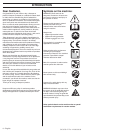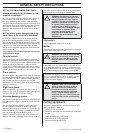
GENERAL SAFETY PRECAUTIONS
English – 9
5451676-47 Rev. 4 2008-08-08
increase your safety and efficiency. Visit your dealer
regularly to see whether you can benefit from new features
that have been introduced.
Personal protective equipment
• Approved protective helmet
• Hearing protection
• Protective goggles or a visor
• Gloves with saw protection
• Trousers with saw protection
• Boots with saw protection, steel toe-cap and non-slip
sole
• Always have a first aid kit nearby.
• Fire Extinguisher and Shovel
Generally clothes should be close-fitting without restricting
your freedom of movement.
Machine′s safety equipment
In this section the machine’s safety features and their
function are explained. For inspection and maintenance
see instructions under the heading Checking, maintaining
and servicing chain saw safety equipment. See
instructions under the heading, What is what?, to find
where these parts are located on your machine.
The life span of the machine can be reduced and the risk
of accidents can increase if machine maintenance is not
carried out correctly and if service and/or repairs are not
carried out professionally. If you need further information
please contact your nearest service workshop.
Chain brake and front hand guard
Your chain saw is equipped with a chain brake that is
designed to stop the chain if you get a kickback. The chain
brake reduces the risk of accidents, but only you can
prevent them.
Take care when using your saw and make sure the
kickback zone of the bar never touches any object.
• The chain brake (A) can either be activated manually
(by your left hand) or automatically by the inertia release
mechanism.
(3)
• The brake is applied when the front hand guard (B) is
pushed forwards.
(3)
• This movement activates a spring-loaded mechanism
that tightens the brake band (C) around the engine drive
system (D) (clutch drum).
(4)
• The front hand guard is not designed solely to activate
the chain brake. Another important feature is that it
reduces the risk of your left hand hitting the chain if you
lose grip of the front handle.
• The chain brake must be engaged when the chain saw
is started to prevent the saw chain from rotating.
• Use the chain brake as a ”parking brake” when starting
and when moving over short distances, to reduce the
risk of moving chain accidentally hitting your leg or
anyone or anything close by.
• To release the chain brake pull the front hand guard
backwards, towards the front handle.
• Kickback can be very sudden and violent. Most
kickbacks are minor and do not always activate the
chain brake. If this happens you should hold the chain
saw firmly and not let go.
• The way the chain brake is activated, either manually or
automatically by the inertia release mechanism,
depends on the force of the kickback and the position of
the chain saw in relation to the object that the kickback
zone of the bar strikes.
If you get a violent kickback while the kickback zone of
the bar is farthest away from you the chain brake is
designed to be activated by the inertia in the kickback
direction.
If the kickback is less violent or the kickback zone of the
bar is closer to you the chain brake will be activated
manually by the movement of your left hand.
• In the felling position the left hand is in a position that
makes manual activation of the chain brake impossible.
With this type of grip, that is when the left hand is placed
so that it cannot affect the movement of the front hand
guard, the chain brake can only be activated by the
inertia action.
Will my hand always activate the chain
brake during a kickback?
No. It takes a certain force to move the hand guard forward.
If your hand only lightly touches the front guard or slips
over it, the force may not be enough to trigger the chain
brake. You should also maintain a firm grip of the chain saw
handles while working. If you do and experience a
kickback, your hand may never leave the front handle and
will not activate the chain brake, or the chain brake will only
activate after the saw has swung around a considerable
distance. In such instances, the chain brake might not have
enough time to stop the saw chain before it touches you.
There are also certain positions in which your hand cannot
reach the front hand guard to activate the chain brake; for
example, when the saw chain is held in felling position.
!
WARNING! Most chain saw accidents
happen when the chain touches the
operator. You must use approved
personal protective equipment whenever
you use the machine. Personal
protective equipment cannot eliminate
the risk of injury but it will reduce the
degree of injury if an accident does
happen. Ask your dealer for help in
choosing the right equipment.
IMPORTANT! Sparks can come from the muffler, the
bar and chain or other sources. Always have fire
extinguishing tools available if you should need them.
Help prevent forest fires.
!
WARNING! Never use a machine with
defective safety components. Safety
equipment must be inspected and
maintained. See instructions under the
heading Checking, maintaining and
servicing chain saw safety equipment. If
your machine does not pass all the
checks, take the saw to a servicing
dealer for repair.


















